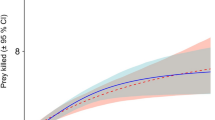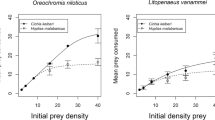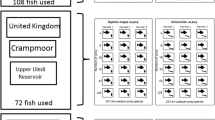Abstract
The European green crab (Carcinus maenas) is invasive on the West coast of North America, but the ecological consequences of this invasion remain poorly understood. Comparative functional response analysis has arisen as a method of elucidating ecological consequences of invasive species by comparing the impact of these species to native analogues. Through comparative functional response experiments of green crabs and native red rock crabs (Cancer productus) we found that green crab predation increased asymptotically (Type II functional response) when fed increasing densities of Pacific oysters (Magallana gigas), while red rock crab predation displayed a sigmoidal (Type III) response. At high oyster densities red rock crabs consume more Pacific oysters than green crabs do, due to their reduced handling time, though green crabs consume more Pacific oysters relative to their size than red rock crabs. However, compared to red rock crabs, green crabs consume more oysters at low prey densities, which implies that they have a larger, potentially destabilizing impact on low densities of Pacific oysters. As green crabs continue to spread across the West coast of North America, Pacific oysters will face increased predation pressure. Our results show the advantage of using functional response analysis to compare density dependent predation between an invasive species and a native species to predict the ecological consequences of invasions.

Similar content being viewed by others
Data availability
The datasets generated during and/or analysed during the current study and the code are available in the CatchCrabs2019 GitHub repository, https://github.com/emilylim13/CatchCrabs2019.
References
Alexander ME, Dick JTA, Weyl OLF et al (2014) Existing and emerging high impact invasive species are characterized by higher functional responses than natives. Biol Lett 10:20130946. https://doi.org/10.1098/rsbl.2013.0946
BC Ministry of Agriculture (2019) British Columbia seafood industry year in review 2017
Behrens Yamada S, Boulding EJ (1998) Claw morphology, prey size selection and foraging efficiency in generalist and specialist shell-breaking crabs. J Exp Mar Biol Ecol 220:191–211. https://doi.org/10.1016/S0022-0981(97)00122-6
Behrens Yamada S, Hunt C (2000) The arrival and spread of the European green crab, Carcinus maenas, in the Pacific Northwest. Driessena 11:1–7
Behrens Yamada S, Davidson TM, Fisher S (2010) Claw morphology and feeding rates of introduced European green crabs (Carcinus maenas L, 1758) and native Dungeness crabs (Cancer magister Dana, 1852). J Shellfish Res 29:471–477. https://doi.org/10.2983/035.029.0225
Chesson J (1989) The effect of alternative prey on the functional response of Notonecta Hoffmani. Ecology 70:1227–1235. https://doi.org/10.2307/1938180
Committee on the Status of Endangered Wildlife in Canada (ed) (2011) COSEWIC assessment and status report on the olympia oyster, Ostrea lurida in Canada. Committee on the Status of Endangered Wildlife in Canada, Ottawa
Conkerton H, Thiet R, Tyrrell M et al (2017) Selection and availability of shellfish prey for invasive green crabs [Carcinus maenas (Linneaus, 1758)] in a partially restored back-barrier salt marsh lagoon on Cape Cod, Massachusetts. J Shellfish Res 36:189–199. https://doi.org/10.2983/035.036.0120
Curtis DL, Sauchyn L, Keddy L et al (2012) Prey preferences and relative predation rates of adult European green crabs (Carcinus maenas) feeding on various bivalve species in British Columbia, Canada. Can Tech Rep Fish Aquat Sci 3014:14
Cuthbert RN, Dickey JWE, Coughlan NE et al (2019) The functional response ratio (FRR): advancing comparative metrics for predicting the ecological impacts of invasive alien species. Biol Invasions 21:2543–2547. https://doi.org/10.1007/s10530-019-02002-z
Dare P, Davies G, Edwards D (1983) Predation on juvenile Pacific oysters (Crassostrea gigas Thunberg) and mussels (Mytilus edulis L.) by shore crabs (Carcinus maenas L.). Fish Res Tech Rep - UK Minist Agric Fish Food Dir Fish Res No 73
Dick JTA, Gallagher K, Avlijas S et al (2013) Ecological impacts of an invasive predator explained and predicted by comparative functional responses. Biol Invasions 15:837–846. https://doi.org/10.1007/s10530-012-0332-8
Dick JTA, Alexander ME, Jeschke JM et al (2014) Advancing impact prediction and hypothesis testing in invasion ecology using a comparative functional response approach. Biol Invasions 16:735–753. https://doi.org/10.1007/s10530-013-0550-8
Dick JTA, Laverty C, Lennon JJ et al (2017) Invader relative impact potential: a new metric to understand and predict the ecological impacts of existing, emerging and future invasive alien species. J Appl Ecol 54:1259–1267. https://doi.org/10.1111/1365-2664.12849
Dickey JWE, Cuthbert RN, South J et al (2020) On the RIP: using relative impact potential to assess the ecological impacts of invasive alien species. NeoBiota 55:27–60. https://doi.org/10.3897/neobiota.55.49547
Dudas SE, McGaw IJ, Dower JF (2005) Selective crab predation on native and introduced bivalves in British Columbia. J Exp Mar Biol Ecol 325:8–17. https://doi.org/10.1016/j.jembe.2005.04.015
Dunn RP, Hovel KA (2020) Predator type influences the frequency of functional responses to prey in marine habitats. Biol Lett 16:20190758. https://doi.org/10.1098/rsbl.2019.0758
Eggleston DB (1990) Functional responses of blue crabs Callinectes sapidus rathbun feeding on juvenile oysters Crassostrea virginica (Gmelin): effects of predator sex and size, and prey size. J Exp Mar Biol Ecol 143:73–90. https://doi.org/10.1016/0022-0981(90)90112-P
Fathipour Y, Karimi M, Farazmand A, Talebi AA (2017) Age-specific functional response and predation capacity of Phytoseiulus persimilis (Phytoseiidae) on the two-spotted spider mite. Acarologia 58:31–40. https://doi.org/10.24349/acarologia/20184425
Gillespie GE (2009) Status of the Olympia Oyster, Ostrea lurida Carpenter 1864, in British Columbia, Canada. J Shellfish Res 28:59–68. https://doi.org/10.2983/035.028.0112
Grosholz ED, Ruiz GM (1996) Predicting the impact of introduced marine species: lessons from the multiple invasions of the European green crab Carcinus maenas. Biol Conserv 78:59–66. https://doi.org/10.1016/0006-3207(94)00018-2
Grosholz E (2002) Ecological and evolutionary consequences of coastal invasions. Trends Ecol Evol 17:22–27. https://doi.org/10.1016/S0169-5347(01)02358-8
Holling CS (1965) The functional response of predators to prey density and its role in mimicry and population regulation. Mem Entomol Soc Can 97:5–60. https://doi.org/10.4039/entm9745fv
Hooff R, Bollens S (2004) Functional response and potential predatory impact of Tortanus dextrilobatus, a carnivorous copepod recently introduced to the San Francisco Estuary. Mar Ecol Prog Ser 277:167–179. https://doi.org/10.3354/meps277167
Howard B, Therriault T, Côté I (2017) Contrasting ecological impacts of native and non-native marine crabs: a global meta-analysis. Mar Ecol Prog Ser 577:93–103. https://doi.org/10.3354/meps12245
Howard BR, Barrios-O’Neill D, Alexander ME et al (2018) Functional responses of a cosmopolitan invader demonstrate intraspecific variability in consumer-resource dynamics. PeerJ 6:e5634. https://doi.org/10.7717/peerj.5634
Hunt CE, Behrens Yamada S (2003) Biotic resistance experienced by an invasive crustacean in a temperate estuary. In: Pederson J (ed) Marine bioinvasions: patterns, processes and perspectives. Springer, Dordrecht, pp 33–43
Long WC, Whitefleet-Smith L (2013) Cannibalism in red king crab: habitat, ontogeny, and the predator functional response. J Exp Mar Biol Ecol 449:142–148. https://doi.org/10.1016/j.jembe.2013.09.004
Lovell D (2007) Modeling economic impacts of the European green crab. Am Agric Econ Assoc Annu Meet 40:1–40
Mascaró M, Seed R (2001) Choice of prey size and species in Carcinus maenas (L.) feeding on four bivalves of contrasting shell morphology. In: Paula JPM, Flores AAV, Fransen CHJM (eds) Advances in decapod crustacean research. Springer, Dordrecht, pp 159–170
Oaten A, Murdoch WW (1975) Functional response and stability in predator-prey systems. Am Nat 109:289–298
Pickering TR, Poirier LA, Barrett TJ et al (2017) Non-indigenous predators threaten ecosystem engineers: Interactive effects of green crab and oyster size on American oyster mortality. Mar Environ Res 127:24–31. https://doi.org/10.1016/j.marenvres.2017.03.002
Poirier LA, Symington LA, Davidson J et al (2017) Exploring the decline of oyster beds in Atlantic Canada shorelines: potential effects of crab predation on American oysters (Crassostrea virginica). Helgol Mar Res 71:13. https://doi.org/10.1186/s10152-017-0493-z
Pritchard DW (2017) frair: tools for functional response analysis. R package version 0.5.100
R Core Team (2019) R: a language and environment for statistical computing. R Foundation for Statistical Computing, Vienna
Rindone RR, Eggleston DB (2011) Predator–prey dynamics between recently established stone crabs (Menippe spp.) and oyster prey (Crassostrea virginica). J Exp Mar Biol Ecol 407:216–225. https://doi.org/10.1016/j.jembe.2011.06.018
Rogers D (1972) Random search and insect population models. J Anim Ecol 41:369–383. https://doi.org/10.2307/3474
RStudio Team (2016) RStudio: Integrated development for R. RStudio, Inc., Boston
Seitz RD, Lipcius RN, Hines AH, Eggleston DB (2001) Density-dependent predation, habitat variation, and the persistence of marine bivalve prey. Ecology 82:2435–2451. https://doi.org/10.2307/2679927
Taylor GM (2000) Maximum force production: why are crabs so strong? Proc Biol Sci 267(1451):1475–1480
Van Leeuwen E, Jansen VAA, Bright PW (2007) How population dynamics shape the functional response in a one-predator-two-prey system. Ecology 88:1571–1581
Walne PR, Davies G (1977) The effect of mesh covers on the survival and growth of Crassostrea gigas Thunberg grown on the sea bed. Aquaculture 11:313–321. https://doi.org/10.1016/0044-8486(77)90080-1
Whiteley NM, El Haj AJ (1997) Regulation of muscle gene expression over the moult in crustacea. Comp Biochem Physiol B Biochem Mol Biol 117(3):323–331
Young AM, Elliott JA (2020) Life history and population dynamics of green crabs (Carcinus maenas). Fishes 5:4. https://doi.org/10.3390/fishes5010004
Acknowledgements
Thanks to the Bamfield Marine Sciences Center (BMSC) for providing space and support, and to NOVA Harvest Ltd. for providing us with oysters. A special thank you to Kate Mill and Allan Roberts for their help setting up and analysing this project, and to Sean Rogers for his valuable feedback prior to submission. We are also endlessly grateful to the many staff and students at BMSC who helped make this project possible. Finally, thanks to the two anonymous reviewers for their comments and suggestions, which greatly improved this manuscript.
Funding
We have no funding to report. This research was supported by the Bamfield Marine Sciences Center through the use of facilities and equipment.
Author information
Authors and Affiliations
Contributions
NJE, EGL and TME conceived and designed the experiments. NJE and EGL performed the experiments and wrote the first draft of the manuscript. NJE, EGL, and BRH performed the analysis. All authors revised the manuscript and approved the final draft.
Corresponding author
Ethics declarations
Conflict of interest
The authors declare that they have no conflict of interest.
Ethics approval
Animal collection and care followed the guidelines set forth by the Canadian Council on Animal Care under the Animal Use Protocol # UP18-FP-DS-1.
Additional information
Publisher’s note
Springer Nature remains neutral with regard to jurisdictional claims in published maps and institutional affiliations.
Supplementary Information
Below is the link to the electronic supplementary material.
Rights and permissions
About this article
Cite this article
Ens, N.J., Lim, E.G., Howard, B.R. et al. A comparison of the predatory impacts of an invasive and native crab species using a functional response approach. Biol Invasions 23, 2329–2336 (2021). https://doi.org/10.1007/s10530-021-02508-5
Received:
Accepted:
Published:
Issue Date:
DOI: https://doi.org/10.1007/s10530-021-02508-5




